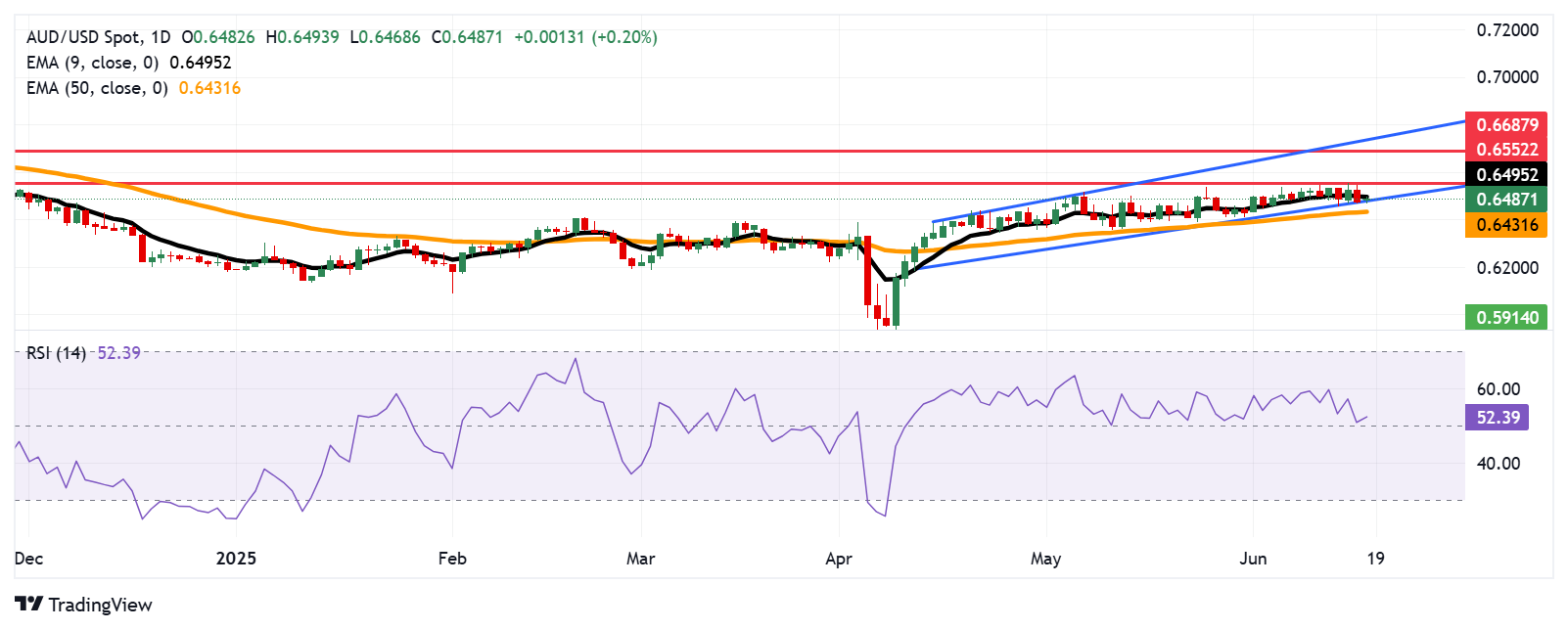Australian Dollar gains ground despite dampened risk sentiment
- The Australian Dollar rebounds after losing more than 0.50% in the previous session.
- The AUD may lose ground due to a risk-off mood as Israel and Iran continue to attack each other.
- The Federal Reserve is widely expected to keep interest rates unchanged on Wednesday.
The Australian Dollar (AUD) edges higher against the US Dollar (USD) on Wednesday after registering more than 0.50% losses in the previous session. However, the AUD/USD pair struggled due to dampened risk appetite amid escalating Middle East tensions. Israel and Iran continue their cycle of retaliation. However, Tehran has reportedly urged several countries, including Oman, Qatar, and Saudi Arabia, to urge US President Donald Trump to declare an immediate ceasefire.
The US Dollar may regain its ground due to increased safe-haven demand amid rising geopolitical tensions in the Middle East. On Tuesday, US President Donald Trump posted on his social media platform, calling for Iran’s “unconditional surrender.” Investors are concerned that the United States will participate in the Israel-Iran conflict.
G7 leaders issued a joint statement on Monday: “We have been consistently clear that Iran can never have a nuclear weapon.” The leaders emphasized that resolving the Iranian crisis could lead to broader de-escalation of hostilities in the region.
Australia’s upcoming labor data, including Employment Change and Unemployment Rate, will be released later this week. The jobs figures will likely offer fresh impetus to the domestic economy and shape expectations for the Reserve Bank of Australia’s (RBA) policy outlook.
Australian Dollar advances as US Dollar edges lower ahead of Fed policy decision
- The US Dollar Index (DXY), which measures the value of the US Dollar against six major currencies, is edging lower and trading at around 98.70 at the time of writing. The Greenback faces challenges due to the weaker-than-expected US Retail Sales released on Tuesday.
- US Retail Sales fell by 0.9% in May, worse than the expected 0.7% decline and April’s 0.1% decrease (revised from +0.1%).
- The Federal Reserve (Fed) is anticipated to leave the interest rate unchanged at the June meeting scheduled on Wednesday. Traders now see a nearly 80% probability of a Fed rate cut in September, followed by another one in October, per Reuters.
- Last week, President Trump expanded steel tariffs starting June 23 on imported “steel derivative products,” including household appliances, such as dishwashers, washing machines, refrigerators, etc. The tariffs were initially imposed at 25% in March and later doubled to 50% for most countries. This is the second time the scope of affected products has been expanded.
- China Retail Sales rose 6.4% year-over-year in May, surpassing the 5.0% expected and April’s 5.1% increase. Meanwhile, Industrial Production increased 5.8% YoY, but came in below the 5.9% forecast and 6.1% prior.
- Moreover, the National Bureau of Statistics (NBS) in China noted that the domestic economy is expected to have remained generally stable for the first half (H1) of 2025. However, economic growth in China may struggle since the second quarter due to uncertain trade policies.
Australian Dollar rebounds from ascending channel’s lower boundary
AUD/USD is trading around 0.6480 on Wednesday, with a prevailing bullish bias as the daily chart’s technical analysis indicates that the pair remains within the ascending channel. Moreover, the 14-day Relative Strength Index (RSI) is positioned slightly above the 50 mark, suggesting a prevailing bullish outlook. However, the pair has moved below the nine-day Exponential Moving Average (EMA), indicating that short-term price momentum is weakening.
The nine-day EMA at 0.6495 is acting as the immediate barrier, followed by the seven-month high of 0.6552, which was recorded on June 16. A break above this level could support the pair to target the eight-month high at 0.6687, followed by the upper boundary of the ascending channel around 0.6740.
On the downside, the AUD/USD pair may target the ascending channel’s lower boundary around 0.6480. A break below the channel would weaken the bullish bias and prompt the pair to test the 50-day EMA at 0.6431.
AUD/USD: Daily Chart

Australian Dollar PRICE Today
The table below shows the percentage change of Australian Dollar (AUD) against listed major currencies today. Australian Dollar was the strongest against the Swiss Franc.
| USD | EUR | GBP | JPY | CAD | AUD | NZD | CHF | |
|---|---|---|---|---|---|---|---|---|
| USD | -0.15% | -0.07% | -0.06% | 0.04% | -0.07% | -0.13% | -0.02% | |
| EUR | 0.15% | 0.08% | 0.08% | 0.11% | -0.02% | 0.09% | 0.14% | |
| GBP | 0.07% | -0.08% | 0.00% | 0.02% | -0.10% | -0.12% | 0.07% | |
| JPY | 0.06% | -0.08% | 0.00% | 0.12% | 0.00% | 0.15% | 0.28% | |
| CAD | -0.04% | -0.11% | -0.02% | -0.12% | -0.10% | -0.14% | 0.05% | |
| AUD | 0.07% | 0.02% | 0.10% | -0.00% | 0.10% | 0.12% | 0.18% | |
| NZD | 0.13% | -0.09% | 0.12% | -0.15% | 0.14% | -0.12% | 0.06% | |
| CHF | 0.02% | -0.14% | -0.07% | -0.28% | -0.05% | -0.18% | -0.06% |
The heat map shows percentage changes of major currencies against each other. The base currency is picked from the left column, while the quote currency is picked from the top row. For example, if you pick the Australian Dollar from the left column and move along the horizontal line to the US Dollar, the percentage change displayed in the box will represent AUD (base)/USD (quote).
Australian Dollar FAQs
One of the most significant factors for the Australian Dollar (AUD) is the level of interest rates set by the Reserve Bank of Australia (RBA). Because Australia is a resource-rich country another key driver is the price of its biggest export, Iron Ore. The health of the Chinese economy, its largest trading partner, is a factor, as well as inflation in Australia, its growth rate and Trade Balance. Market sentiment – whether investors are taking on more risky assets (risk-on) or seeking safe-havens (risk-off) – is also a factor, with risk-on positive for AUD.
The Reserve Bank of Australia (RBA) influences the Australian Dollar (AUD) by setting the level of interest rates that Australian banks can lend to each other. This influences the level of interest rates in the economy as a whole. The main goal of the RBA is to maintain a stable inflation rate of 2-3% by adjusting interest rates up or down. Relatively high interest rates compared to other major central banks support the AUD, and the opposite for relatively low. The RBA can also use quantitative easing and tightening to influence credit conditions, with the former AUD-negative and the latter AUD-positive.
China is Australia’s largest trading partner so the health of the Chinese economy is a major influence on the value of the Australian Dollar (AUD). When the Chinese economy is doing well it purchases more raw materials, goods and services from Australia, lifting demand for the AUD, and pushing up its value. The opposite is the case when the Chinese economy is not growing as fast as expected. Positive or negative surprises in Chinese growth data, therefore, often have a direct impact on the Australian Dollar and its pairs.
Iron Ore is Australia’s largest export, accounting for $118 billion a year according to data from 2021, with China as its primary destination. The price of Iron Ore, therefore, can be a driver of the Australian Dollar. Generally, if the price of Iron Ore rises, AUD also goes up, as aggregate demand for the currency increases. The opposite is the case if the price of Iron Ore falls. Higher Iron Ore prices also tend to result in a greater likelihood of a positive Trade Balance for Australia, which is also positive of the AUD.
The Trade Balance, which is the difference between what a country earns from its exports versus what it pays for its imports, is another factor that can influence the value of the Australian Dollar. If Australia produces highly sought after exports, then its currency will gain in value purely from the surplus demand created from foreign buyers seeking to purchase its exports versus what it spends to purchase imports. Therefore, a positive net Trade Balance strengthens the AUD, with the opposite effect if the Trade Balance is negative.

